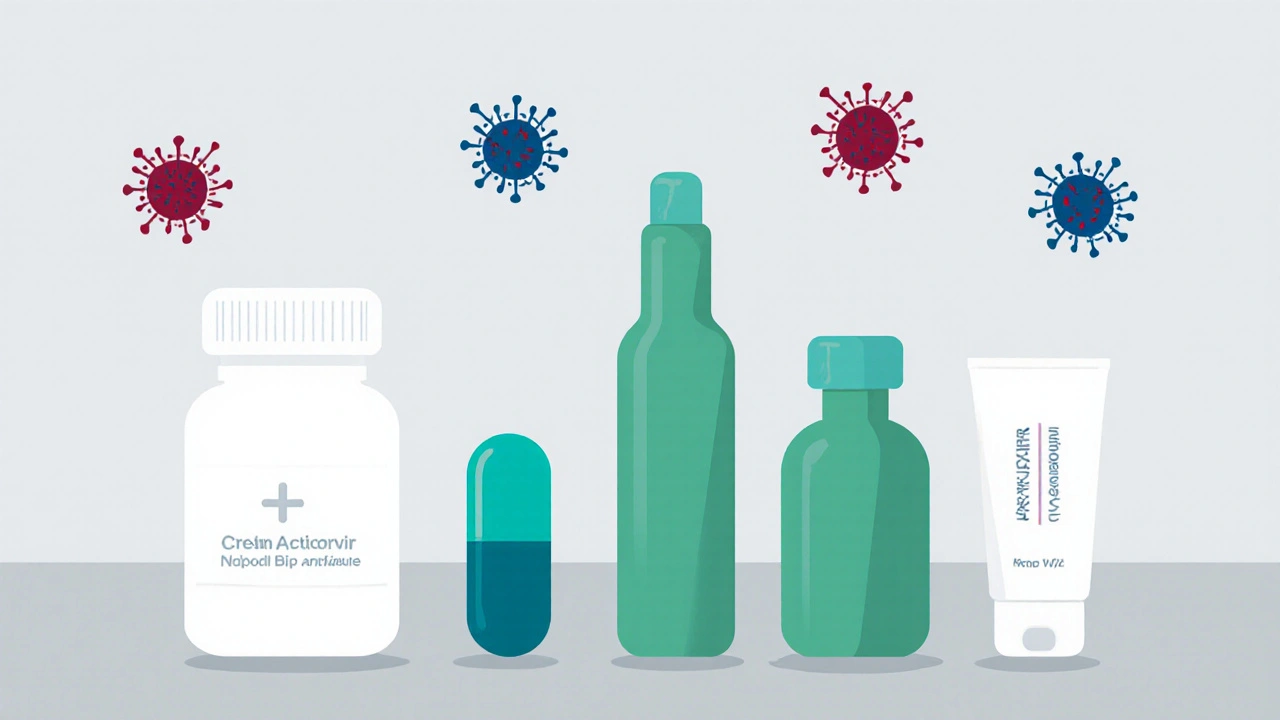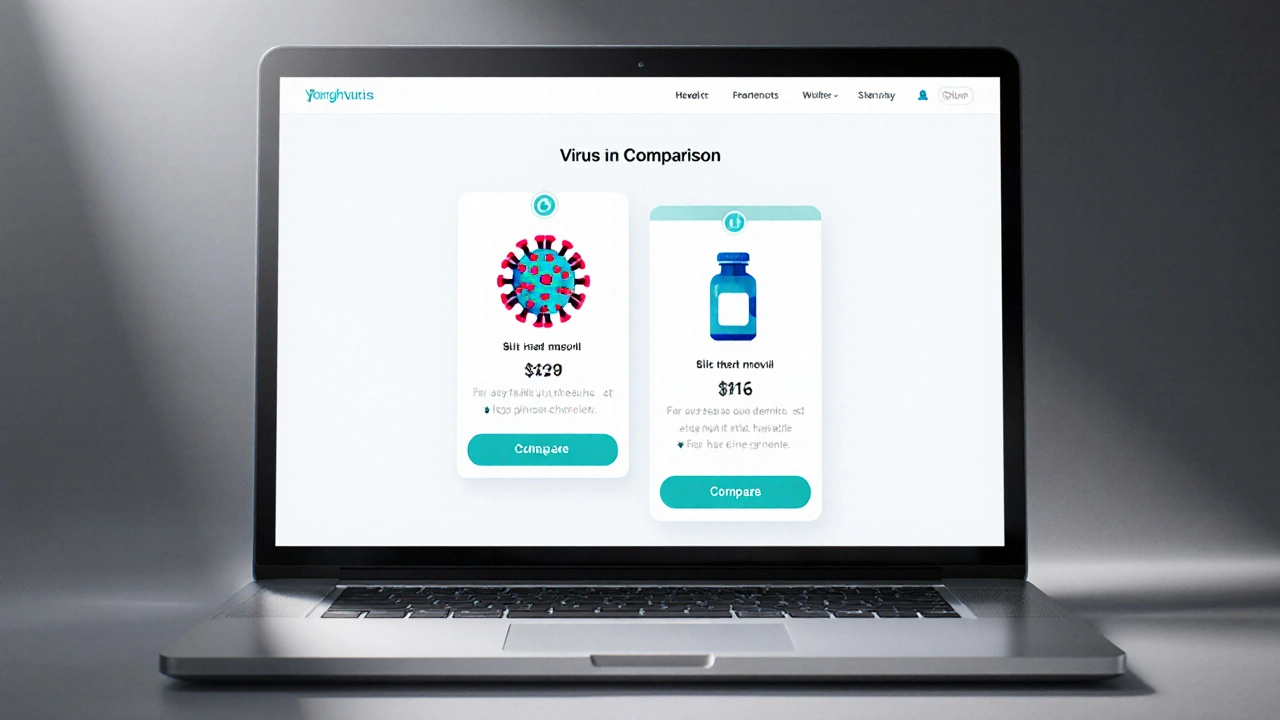Antiviral Medication Comparison Tool
Medication Details
Dosing Information
Key Advantages
Important Safety Note
All medications have similar safety profiles with rare serious side effects. Discuss with your clinician if you are pregnant, elderly, or have renal impairment.
Key Takeaways
- Aciclovir works well for mild outbreaks but requires multiple daily doses.
- Valacyclovir and famciclovir offer higher oral bioavailability, so you can take them once or twice a day.
- Kidney function, cost, and the specific virus (HSV vs VZV) drive the final choice.
- All four drugs share similar safety profiles; serious side effects are rare.
- Discuss dosing adjustments with a clinician if you are pregnant, elderly, or have renal impairment.
What Is Aciclovir?
Aciclovir is a synthetic nucleoside analogue that interferes with viral DNA replication, mainly targeting herpes simplex virus (HSV) and varicella‑zoster virus (VZV). First approved in the early 1980s, it remains a cornerstone for treating cold sores, genital herpes, shingles, and, in severe cases, viral encephalitis. The drug is available as topical cream, oral tablets, and intravenous injection, giving clinicians flexibility based on infection severity.
Why Look for Alternatives?
Aciclovir is effective, but it isn’t perfect. The oral tablets have a relatively low bioavailability-about 15‑30%-which means you need to take them three to five times a day to keep blood levels therapeutic. Frequent dosing can hurt adherence, especially for people juggling work or school. Additionally, patients with reduced kidney function must have their dose lowered, and resistance, though uncommon, can emerge in immunocompromised individuals.
These challenges have spurred the development of newer analogues that stay longer in the bloodstream, require fewer doses, and still target the same viruses. The most widely used alternatives are valacyclovir, famciclovir, and penciclovir (the latter mostly as a topical cream).
Spotlight on the Main Alternatives
Valacyclovir is a prodrug of aciclovir that converts into the active molecule after absorption, boosting oral bioavailability to roughly 55‑70%. Because more of the drug reaches the bloodstream, you can usually take it once or twice daily.
Famciclovir is another prodrug that becomes penciclovir in the body, delivering about 77% oral bioavailability. Like valacyclovir, it shortens dosing schedules and works well for HSV and VZV.
Penciclovir is the active form of famciclovir, marketed mainly as a 1% cream for cold‑sore treatment. It stays longer inside infected cells, which can speed up lesion healing when applied early.
Some clinicians still refer to Acyclovir as an alternate spelling for aciclovir, especially in North American literature. For the purpose of this guide, we treat them as the same molecule.

Side‑by‑Side Comparison
| Attribute | Aciclovir | Valacyclovir | Famciclovir | Penciclovir (cream) |
|---|---|---|---|---|
| Form | Tablet, IV, topical ointment | Tablet | Tablet | 1% cream |
| Oral Bioavailability | 15‑30% | 55‑70% | ~77% | Topical, ~70% skin penetration |
| Typical Dosing Frequency | 3‑5times/day | 1‑2times/day | 2‑3times/day | 5times/day (apply every 2‑3h) |
| Key Indications | HSV‑1, HSV‑2, VZV, herpes encephalitis | HSV outbreaks, shingles, genital herpes suppression | HSV outbreaks, shingles, genital herpes suppression | Cold‑sores (HSV‑1) |
| Onset of Relief | 48‑72h | 24‑48h | 24‑48h | Within 24h (if applied early) |
| Typical Cost (US, 2025) | $0.15pertablet | $0.30pertablet | $0.35pertablet | $0.25pergram |
| Renal Dose Adjustment | Yes, required for CrCl<30mL/min | Yes, but less frequent dosing | Yes, similar to valacyclovir | Not applicable (topical) |
How to Choose the Right Antiviral
Pick the drug that lines up with three core factors: virus type, patient lifestyle, and renal function. Below is a quick decision guide you can run through with your clinician.
- Identify the virus. If you’re dealing with a shingles episode (VZV), any of the three oral agents work, but valacyclovir is often preferred for its once‑daily dosing in elderly patients.
- Assess dosing convenience. People who travel or have erratic schedules may favor valacyclovir (once daily) or famciclovir (twice daily). If you can manage five doses a day, aciclovir remains a cost‑effective option.
- Check kidney health. All four drugs are cleared renally, but the prodrugs need less aggressive dose reduction. Patients with CrCl<30mL/min often stay on reduced‑dose aciclovir IV in hospital settings, while outpatient care shifts to low‑dose valacyclovir.
- Factor in cost. Aciclovir tablets are the cheapest, making them a go‑to for self‑pay patients. Insurance plans frequently cover the branded prodrugs, but copays can still be higher.
- Consider special populations. Pregnant women usually receive aciclovir because safety data are extensive. For immunocompromised patients (e.g., transplant recipients), IV aciclovir is still the standard for severe infections, but oral valacyclovir can be used for prophylaxis.
Pros and Cons at a Glance
Aciclovir - Pros: inexpensive, available IV for severe cases, long track record. Cons: multiple daily doses, lower bioavailability, more renal dose tweaks.
Valacyclovir - Pros: high bioavailability, once‑daily dosing for suppression, fewer dose‑adjustments. Cons: higher price, still requires renal adjustments.
Famciclovir - Pros: excellent bioavailability, good for shingles, flexible dosing (twice daily). Cons: similar cost to valacyclovir, limited data in pregnancy.
Penciclovir cream - Pros: direct to lesion, shortens healing if used early, no systemic side effects. Cons: only for cold‑sores, must apply frequently.
Practical Tips for Patients
- Start therapy within 24hours of symptom onset for the best outcome.
- Stay hydrated; adequate fluids help kidneys clear the drug and reduce crystal formation (a rare side effect of aciclovir).
- If you miss a dose, take it as soon as you remember unless it’s close to the next scheduled dose.
- Never combine these antivirals with other nephrotoxic meds (e.g., high‑dose NSAIDs) without doctor approval.
- Keep a medication list handy during doctor visits; it speeds up dose‑adjustment decisions.

Frequently Asked Questions
Frequently Asked Questions
Can I switch from aciclovir to valacyclovir mid‑treatment?
Yes, but only under medical supervision. The two drugs have different half‑lives, so a short overlap or a brief gap may be needed to keep antiviral coverage steady.
Are there any food restrictions with these antivirals?
Valacyclovir and famciclovir can be taken with or without food. Aciclovir tablets absorb slightly better on an empty stomach, but the difference is minor.
What should I do if I develop a rash while on aciclovir?
Stop the medication and call your healthcare provider immediately. While skin reactions are uncommon, they can signal hypersensitivity that requires a switch to an alternative.
Is it safe to use penciclovir cream together with oral antivirals?
Yes, topical penciclovir works locally and does not interact with systemic drugs. Using both can speed up healing for cold‑sores.
How does kidney disease change dosing for these antivirals?
Reduced renal clearance means the drug stays longer in the bloodstream, increasing the risk of toxicity. For aciclovir, the dose may be halved or given every 8‑12hours. Valacyclovir and famciclovir also need dose cuts, but because they are taken less frequently, the adjustment is often simpler.


Christian James Wood
Let me break down why the hype around aciclovir is, frankly, a relic of the past; the drug’s low bioavailability forces patients into a burdensome three‑to‑five‑times‑daily regimen, which in practice translates into sub‑optimal adherence and lingering viral activity.
When you compare that to valacyclovir’s 55‑70% oral availability, the difference is not merely academic but clinically significant, shaving off doses and ensuring steadier plasma concentrations.
Moreover, the pharmacokinetic profile of famciclovir, boasting roughly 77% bioavailability, further underscores the inadequacy of clinging to a drug that was once a breakthrough but now serves as a baseline comparator.
Patients with compromised renal function need dose reductions for aciclovir, a nuance that complicates prescribing patterns and raises the specter of nephrotoxicity if mismanaged.
Resistance, although rare, does emerge in immunocompromised hosts, and the selective pressure exerted by continuous low‑level exposure to aciclovir can foster viral mutations that blunt therapeutic efficacy.
From a cost perspective, while aciclovir may appear cheaper on the surface, the hidden costs of frequent dosing, potential hospitalizations for breakthrough infections, and the need for therapeutic drug monitoring can erode any superficial savings.
In contrast, the prodrugs valacyclovir and famciclovir provide a streamlined dosing schedule that aligns better with modern patients’ lifestyles, reducing pill fatigue and improving quality of life.
The convenience factor is not trivial; a once‑daily regimen increases the likelihood of adherence, which is a cornerstone of effective antiviral therapy.
Clinical guidelines now often prioritize these newer agents for both initial and recurrent episodes of HSV and VZV, reflecting a shift in the standard of care toward more patient‑centric options.
Furthermore, the pharmacodynamic advantage of higher plasma peaks achieved with valacyclovir and famciclovir translates into more rapid viral suppression, shortening lesion duration and mitigating transmission risk.
When evaluating safety, the adverse event profiles of all four medications remain comparable, but the reduced dosing frequency of the newer agents minimizes the exposure window for potential side effects.
Topical penciclovir, while limited to cold‑sore applications, offers a mechanistic benefit of prolonged intracellular retention, speeding up lesion healing when applied early.
In practice, the decision matrix should weigh bioavailability, dosing convenience, renal considerations, and patient preference rather than defaulting to aciclovir out of habit.
Thus, the narrative that “acyclovir works fine” is an oversimplification that neglects the evolution of antiviral pharmacotherapy over the past four decades.
Clinicians would be well advised to reassess their prescribing algorithms and consider the superior pharmacokinetic and adherence profiles of valacyclovir or famciclovir for most patients.
October 4, 2025 AT 14:38
Rebecca Ebstein
Wow, this guide really helps clear things up! I love how it shows the pros and cons without being too technical. Definitely gonna share this with my sister who’s dealing with frequent cold sores – she’ll appreciate the simpler dosing options. Nice work! :)
October 6, 2025 AT 11:02
Artie Alex
In reference to the preceding exposition, it is imperative to acknowledge the kinetic disparities intrinsic to the nucleoside analogues delineated herein. The prodrug conversion efficiency of valacyclovir, quantified at a bioavailability of 55‑70%, engenders a pharmacokinetic envelope conducive to sustained therapeutic plasma concentrations. Conversely, the parent compound aciclovir, constrained by a mere 15‑30% absorption fraction, mandates a polyphasic dosing schema to surmount subtherapeutic troughs. Such pharmacodynamic considerations are pivotal when orchestrating regimen adherence in poly‑pharmacy contexts. Moreover, the renal excretion pathways necessitate dosage modulation predicated upon glomerular filtration rates, an element frequently obfuscated in lay discourse. The clinical ramifications of suboptimal dosing intervals precipitate virological rebound, thereby potentiating resistance phenotypes within immunocompromised cohorts. Hence, a judicious appraisal of drug‑specific pharmacokinetic parameters is requisite for optimizing antiviral stewardship.
October 8, 2025 AT 07:26
abigail loterina
If you’re trying to pick the right antiviral, think about how often you’re willing to take a pill. Valacyclovir and famciclovir are great if you hate taking meds multiple times a day. They’re just as safe as aciclovir, but way easier on your schedule.
October 10, 2025 AT 03:50
Roger Cole
Good points, especially about dosing frequency.
October 12, 2025 AT 00:14
Krishna Garimella
Life is full of tiny choices, and picking the right medication is one of those subtle decisions that ripple through our daily rhythm. When you consider a drug that fits seamlessly into your routine, you’re not just treating a virus; you’re honoring your time, your focus, and your peace of mind. The elegance of a once‑daily dose is not merely convenience-it’s a statement that health can coexist with a busy life, without demanding constant sacrifice. So, as you weigh aciclovir against its newer siblings, remember that the best medicine is the one you’ll actually take, consistently, and with confidence.
October 13, 2025 AT 20:38
nalina Rajkumar
Totally agree 😊 this info is super helpful 🙌 thanks for sharing!
October 15, 2025 AT 17:02
Michael Barrett
The table summary is spot on.
October 17, 2025 AT 13:26
Inma Sims
While the data presented is undeniably thorough, one cannot help but marvel at the sheer convenience of modern pharmacotherapy-indeed, a marvel that perhaps renders the archaic regimens of yesteryear almost quaint in comparison. One might even suggest that the reader, armed with this knowledge, will soon find themselves eschewing the nocturnal dosing nightmares that once plagued the ... well, let us say, ‘older’ generation of antiviral users.
October 19, 2025 AT 09:50
Gavin Potenza
Alright, so here’s the lowdown: valacyclovir and famciclovir basically give you the same antiviral punch as aciclovir but with fewer pills. That’s a win for anyone who hates juggling meds. Still, if cost is a factor, aciclovir can be the budget-friendly option, just be ready to pop them multiple times a day.
October 21, 2025 AT 06:14
Virat Mishra
Another thing: people love to hype up newer drugs but forget older ones still work fine if you’re diligent.
October 23, 2025 AT 02:38
Daisy Aguirre
Hey folks, 🌍 let’s celebrate the diversity of treatment options! Whether you’re from a bustling city or a quiet town, having choices like valacyclovir, famciclovir, or even the classic aciclovir means you can tailor therapy to your lifestyle and culture. It’s empowering to know that science respects the kaleidoscope of human experience.
October 24, 2025 AT 23:02
Natalie Kelly
Nice summary, thanks!
October 26, 2025 AT 18:26
Tiffany Clarke
Aciclovir is okay but newer drugs win.
October 28, 2025 AT 14:50
Sandy Gold
Honestly, the whole obsession with “newer is better” is a bit of a myth-if you read the primary literature, you’ll see that valacyclovir’s superiority isn’t as clear‑cut as popular articles suggest. In fact, for certain immunocompromised patients, aciclovir’s longer history of use provides a safety net that newer agents haven’t fully established yet.
October 30, 2025 AT 11:14
Frank Pennetti
Look, we’re talking about American meds here-why bother with foreign alternatives? Stick with what’s proven in our labs.
November 1, 2025 AT 07:38
Adam Baxter
Stay motivated, pick the drug that fits your life, and you’ll beat those outbreaks!
November 3, 2025 AT 04:02
Keri Henderson
Remember, adherence is key-choose the regimen you can actually stick with.
November 5, 2025 AT 00:26
elvin casimir
First off, “valacyclovir” is just a fancy name for a pro‑drug; it doesn’t magically make it superior in all cases. Second, the emphasis on “once‑daily dosing” ignores the fact that some patients need higher trough levels only achievable with multiple dosing. Finally, the claim that aciclovir is outdated is a misconception; its safety profile is still unmatched.
November 6, 2025 AT 20:50
Steve Batancs
From a policy standpoint, it is prudent to prioritize medications that have demonstrated efficacy within the United States regulatory framework, thereby ensuring compliance with national health standards.
November 8, 2025 AT 17:14